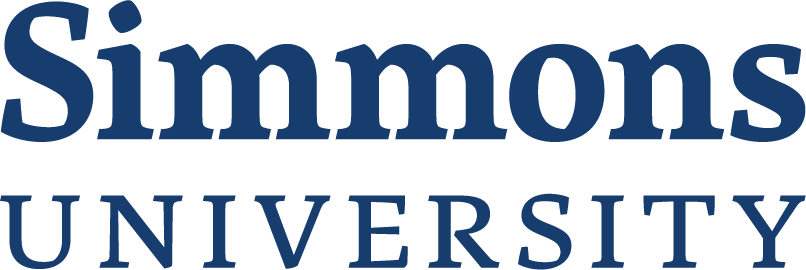Field Trip to BPL Digital Imaging Studios and Harvard University Film Preservation Lab
Posted November 24, 2025 by Brooke Thomson
- The Boston Public Library’s Digital Imaging Studios
Hi readers! This week, I wanted to tell you all about my recent archival adventures. November 12th was an exciting day for the students of LIS 448 Digital Stewardship—we went on a field trip! For the first time since moving here, I donned my one and only winter coat and scarf, then hopped on the green line to Copley station. My destination? 700 Boylston St, AKA the Boston Public Library! Technically, it’s “Boston Public Library—Central Library in Copley Square,” but that’s a mouthful. I’ve found since moving here that most of us skip the “Central” when referring to this particular branch, and just say “BPL.”
Once everybody arrived, Dr. Botticelli led us to a conference room in the Kirstein Business Library & Innovation Center (KBLIC) to meet the BPL professionals giving us our tour. Some of them were:
Jessica Chapel—Chief of Digital & Online Services
Eben English—Digital Repository Services Manager
Jade Alderman—Digital Imaging Production Assistant
Things started with the staff giving us some background about their roles at the library and how each of them ended up there. Then they opened up the floor for questions, which resulted in a funny deer-in-headlights moment for the whole class. “Questions?” I’m sure we all thought at the same time, “What questions?! We just got here!” But thankfully someone did have a question, and things moved pretty smoothly from there.
After some back and forth, they then split us into groups, herded us down a hallway, and through a pair of rather non-descript doors. The immediate area was a large room occupied by a grid of black tents, tables and some rolling carts full of books. These black tents were work stations for employees of the Internet Archive, whom the BPL partners with. At least three were occupied. It was hard to see much from a distance, but I could still make out the back of each digitizer as they leaned over their brightly lit work stations. They routinely lifted a large piece of V-shaped glass, flipped a page, then pressed on a foot pedal beneath the table to send the glass back down and take a photo of the open book. The result appeared on a nearby monitor. I didn’t know that the Boston Public Library had this relationship with Internet Archive, so it was neat to say hello to those workers and learn how they fit into the picture.
For our tour, my group cycled through Digital Imaging Rooms 1, 2 and 3. Each room was geared towards a slightly different task. Unfortunately, I don’t remember the names of every piece of equipment, but I’ve got pictures!

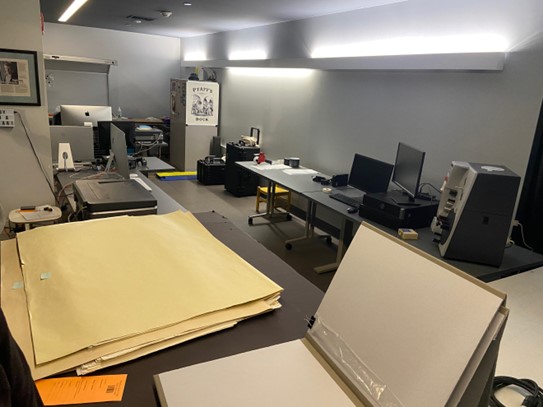

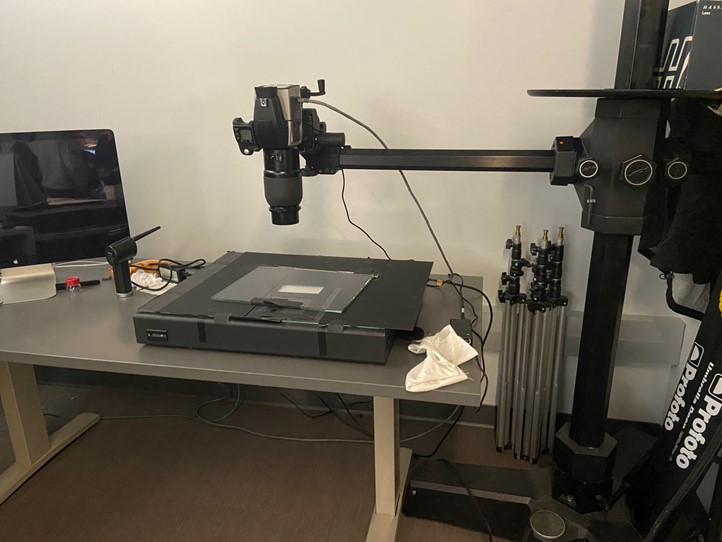
Something I do remember by name is the BC100 set up. This “high-resolution book scanning system has two cameras to capture images of both sides of a book simultaneously,” and is primarily meant to scan fragile materials. This is because the BC100 uses a compressor operator to move the glass, rather than a less-precise foot pedal. Jade gave us a demonstration of her current project and answered some questions about her experience. For example, I was surprised to find that the work light illuminating her station was so bright it actually bothered my eyes—not good if I want to work with similar equipment in the future! I asked her if she ever got headaches or over-heated after prolonged exposure to the light and machines in an otherwise dark and small space, but she said thankfully not. For more information about the BC100 and Jade’s work, check out these blogs: Photographing a loose-leaf binder under the BC100 book scanning station and Meet the BPL’s new Digital Imaging Production Assistant!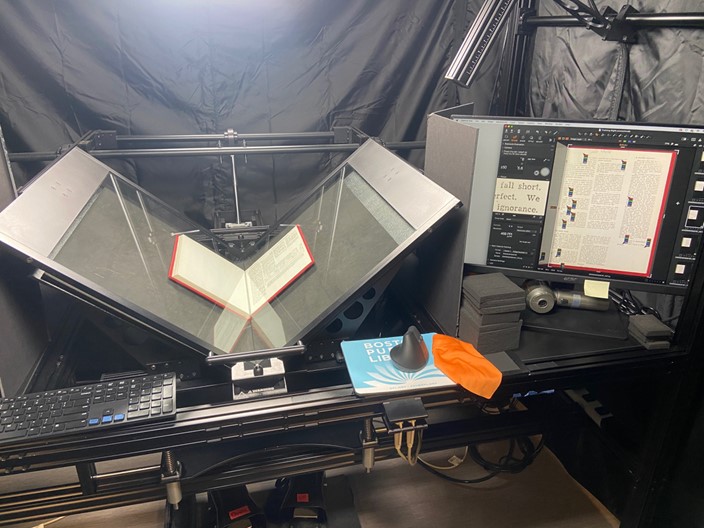
Outside of the Digital Imaging Labs with their various cameras and scanners, we also got a presentation on Digital Commonwealth. Once upon a time, the BPL shared their digital collections on Flickr! The online traffic there was justification for the development of a more sophisticated repository, and that’s where we get Digital Commonwealth! You can still check out the Flickr stuff if you’re interested—here’s a link.
I was told that, “99% of what gets digitized in these rooms ends up in Digital Commonwealth.” Wondering how long it takes to digitize a book? It depends on fragility, but most 300-page books will take about an hour. Eben walked us through different examples of Digital Commonwealth items and their metadata, touching on how the BPL backs up that information. We also talked about binary files (JPEG + TIFF), primary files (camera/outcome) and derivative files (these depend on content-type, but can include: text, OCR, XML, JSAN files and technical metadata).
One example we studied was a book from the Boston Symphony Orchestra Score Collection. It got me wondering if I could arrange a field trip to the Boston Symphony Archives for Panopticon (my club). We’re slacking on the ‘music’ front, so this could be a way to fix that… Is anybody interested in historical sheet music??
Something I enjoyed learning about was the BPL’s OCR (optical character recognition) models for transcription and translation. We had a good discussion about the finer details of translating text and almost everyone in the room agreed a human touch was necessary for it. Language changes over time and is very seldom represented with an easy one-to-one translation. This was related to a larger conversation on the role of AI in this process and whether or not we think it will actually help. Our tentative answer was no: the reliability of AI powered translations is only as good as the sources it’s pulling from, and workers would still need to spend significant time vetting these translations for accuracy and counter-act any inherent biases or errors in the AI.
- The Film Preservation Lab at Weissman Preservation Center, Harvard University
Now for the next field trip! On November 17th, I joined SLIS’s own student chapter of AMIA (Association of Moving Image Archivists) on a tour of the Film Preservation Lab at the Weissman Preservation Center. I’m not 100% sure what the correct label is, “Film Preservation Lab” or “Film Conservation Center.” The club used the first one, so that’s what I’ll go with here!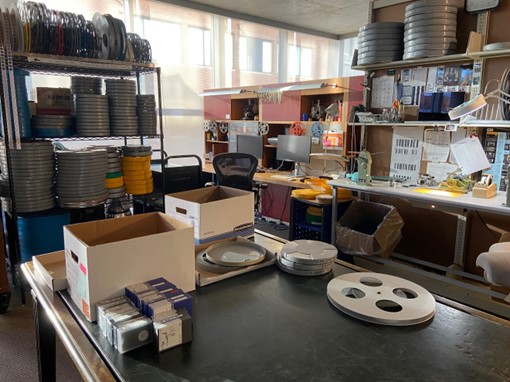
It was my first time wandering that way, so I started my day with a walk around Harvard campus, followed by some breakfast and homework at The Friendly Toast. It was an overcast day with lots of biting wind, so I stayed cooped up in the restaurant until it was time to meet AMIA for our tour. Eventually I found my group gathered outside the door to 90 Mt Auburn St. Everybody exchanged introductions and commiserated about how cold it was for a few minutes. We had a mix of students attending. Some (like me) in their first semester, some students about to graduate, and even one who wasn’t a student at all—but thinking about applying to Simmons SLIS.
Our tour guide was Melanie Meents, the Senior Time-Based Media Conservator of Harvard’s Media Preservation Services department. She introduced us to her coworker, Adrianne Jorge. Adrianne’s title is Film Conservator. She and Melanie make up the film preservation team at this particular location; a team of just two.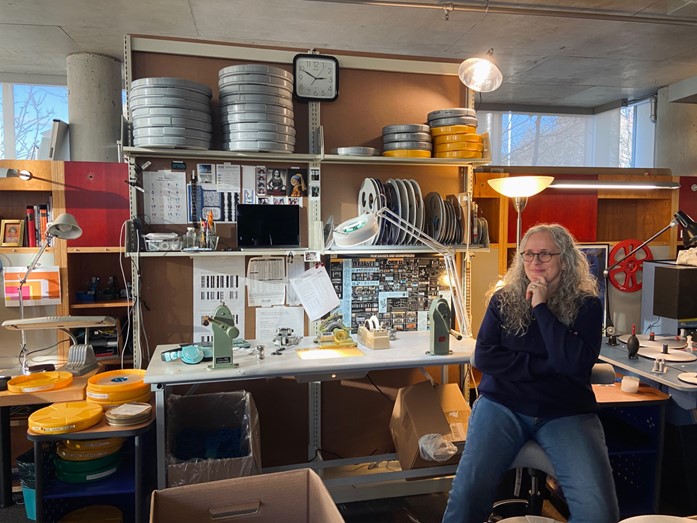
The lab itself was a small space, maybe 20×10 if I had to hazard a guess. In it were shelves full of film cases and archival boxes, tables with overhead lights and scattered tools, and various pieces of equipment, like the big Steenbeck flatbed editor. I have approximately 0 experience with AV (audio-visual) archives, so I was learning about a lot of things for the first time. A lot of genre-specific language got thrown around so sometimes I got lost, but I kind of expected that to happen. 16 mm, 35 mm, vinegar syndrome, nitrate, something about super 8…I did my best, okay!
Most of what Melanie and Adrianne handle comes from the Harvard Film Archives. Adrianne was working on a collection of educational videos in Korean from the 1970s when we showed up. Because of my digital stewardship class, I had digitization on my mind, and asked about what that looked like for them. The answer is: Melanie and Adrianne don’t actually do digitization themselves. Their role is to assess and preserve materials before sending them on their way to another department, like the folks who digitize in a nearby building. They also explained that they don’t outright repair things so much as take steps to preserve them in their current condition.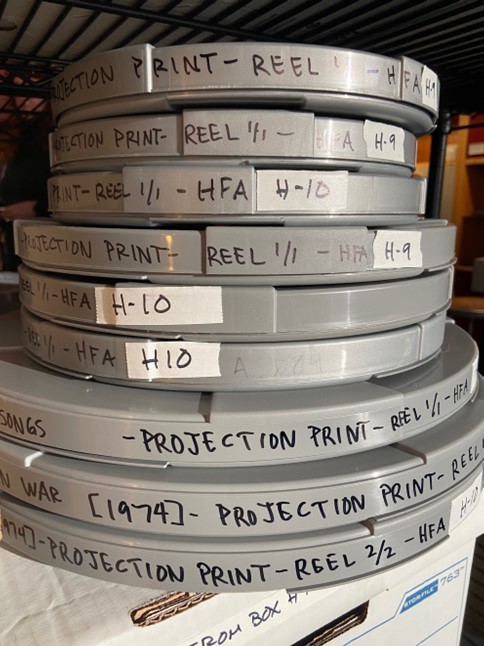
One topic I really enjoyed learning about was a water incident that occurred at the Harvard Film Archives recently. Just last month, in early October, a pipe burst and flooded the HFA’s theater, collections and offices. While there was no significant damage, it reminded me of the time a pipe burst and flooded the archives of Florida State University on Christmas night in 2022. I’m very interested in the preventative and responsive measures put in place to handle incidents like this, so I took the opportunity to learn what I could about the AV side of things. Melanie was called in to help mitigate the situation. One thing she mentioned is that when film gets wet, they have no good way to dry and take care of it on their own. The number one issue is space! Film reels tend to be hundreds of feet long. The best thing to do is send the wet ones off to some specialists who have the space and means to hang them properly.
Like most LAMs, this lab also has a backlog of material to get through. At the end of our tour Melanie brought us to a small room chalk full of boxes on shelves and pallets. She exasperatedly pointed out that just when they had finally cleared one pallet, new material arrived to fill it up again.
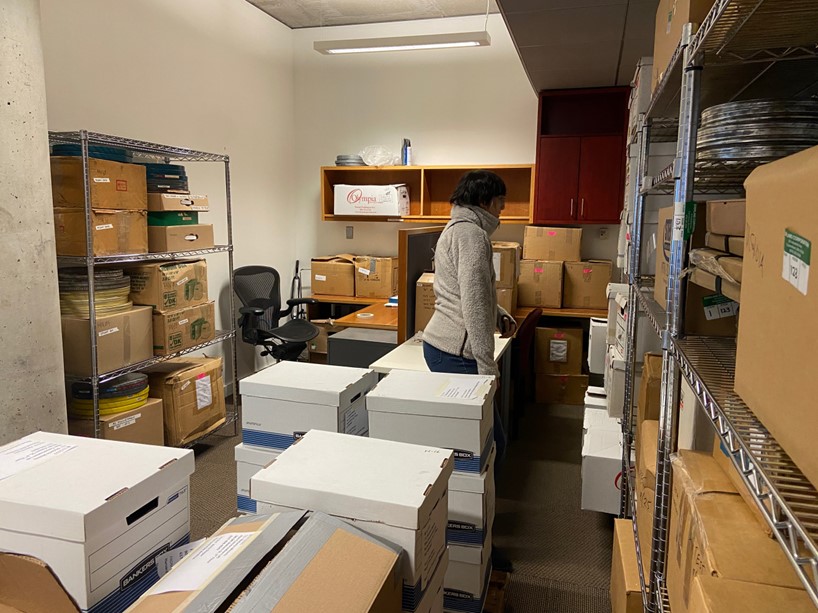
And that’s it! I’m grateful for these kinds of excursions, because on one hand they’re just cool and on the other I get to hear valuable advice from current professionals in the field. I look forward to more adventures like them!
Please enjoy this One Battle After Another (2025) format guide:

